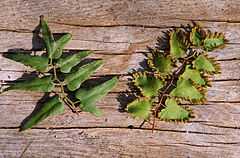Lygodium microphyllum
| Lygodium microphyllum | |
|---|---|
 | |
| Underside of spore-bearing leaflets, some leaflets produce spores; others don't. | |
| Conservation status | |
| Scientific classification | |
| Kingdom: | Plantae |
| Division: | Pteridophyta |
| Class: | Polypodiopsida / Pteridopsida (disputed) |
| Order: | Schizaeales |
| Family: | Lygodiaceae |
| Genus: | Lygodium |
| Species: | L. microphyllum |
| Binomial name | |
| Lygodium microphyllum (Cav.) R.Br.[1] | |
| Synonyms[1][2][3] | |
Lygodium microphyllum (commonly known as, variously, climbing maidenhair fern,[1] Old World climbing fern,[1] small-leaf climbing fern,[1] or snake fern) is a climbing fern originating in tropical Africa, South East Asia, Melanesia and Australia.[1] It is an invasive weed[4] in the US States of Florida and Alabama where it invades open forest and wetland areas. The type specimen was collected in the vicinity of Nabúa, on the Island of Luzon in the Philippines by Luis Née.[5]
Distribution
Lygodium microphyllum is native to Africa (in Angola, Burundi, Cameroon, Côte d'Ivoire, the Democratic Republic of the Congo, Gabon, Ghana, Guinea-Bissau, Kenya, Liberia, Mozambique, Nigeria, Senegal, Sierra Leone, Tanzania (including the Zanzibar Archipelago), Uganda, Zambia, Zimbabwe, and KwaZulu-Natal in South Africa); Asia (in Brunei, India, Indonesia, Malaysia, Papua New Guinea, the Philippines, Taiwan, Thailand, the provinces of Fujian, Guangdong, Guangxi, Yunnan of China, and the Ryukyu Islands of Japan); Australia (in Northern Territory, Queensland, northeast New South Wales, and northern Western Australia); and the Pacific Islands of Fiji, and Micronesia's Mariana Islands and Caroline Islands.[1]
Lygodium microphyllum has become naturalized in the Caribbean and the southeastern United States.[1]
Ethnobotany
Lygodium microphyllum has been used locally in folk medicine to treat skin ailments, swelling and dysentery.[7]
References
- ↑ 1.0 1.1 1.2 1.3 1.4 1.5 1.6 1.7 Under its treatment as Lygodium microphyllum (from its basionym of Ugena microphylla), this species name was published first in Prodromus Florae Novae Hollandiae 162. 1810. GRIN (September 10, 2008). "Lygodium microphyllum information from NPGS/GRIN". Taxonomy for Plants. National Germplasm Resources Laboratory, Beltsville, Maryland: USDA, ARS, National Genetic Resources Program. Retrieved November 2, 2011.
- ↑ Ugena microphylla, the basionym of L. microphyllum, was first described and published in Icones et Descriptiones Plantarum 6: 76, pl. 595, f. 2. 1801. GRIN (November 5, 2002). "Ugena microphylla information from NPGS/GRIN". Taxonomy for Plants. National Germplasm Resources Laboratory, Beltsville, Maryland: USDA, ARS, National Genetic Resources Program. Retrieved November 2, 2011.
- ↑ "Name - Ugena microphylla Cav. synonyms". Tropicos. Saint Louis, Missouri: Missouri Botanical Garden. Retrieved November 2, 2011.
- ↑ "Global Fire Initiative: Fire and Invasives". The Nature Conservancy. Retrieved 2008-12-12.
- ↑ "Name - Ugena microphylla Cav.". Tropicos. Saint Louis, Missouri: Missouri Botanical Garden. Retrieved November 2, 2011.
- ↑ Volin, John C.; Kruger, Eric L.; Volin, Valeria C.; Tobin, Michael F.; Kitajima, Kaoru (2009). "Does release from natural belowground enemies help explain the invasiveness of Lygodium microphyllum? A cross-continental comparison". Plant Ecology 208 (2): 223. doi:10.1007/s11258-009-9700-6.
- ↑ James A. Duke. "Lygodium microphyllum (SCHIZAEACEAE)". Dr. Duke's Phytochemical and Ethnobotanical Databases. Retrieved November 2, 2011.
| Wikimedia Commons has media related to Lygodium microphyllum. |
External links
- Species Profile- Old World Climbing Fern (Lygodium microphyllum), National Invasive Species Information Center, United States National Agricultural Library. Lists general information and resources for Old World Climbing Fern.
Bibliography
- Jeffrey T. Hutchinson, Kenneth A. Langeland, Gregory E. MacDonald and Robert Querns, 2010; Absorption and Translocation of Glyphosate, Metsulfuron, and Triclopyr in Old World Climbing Fern (Lygodium microphyllum). Weed Science 58:2, 118-125 Online publication date : 1-Apr-2010 (abstract)
